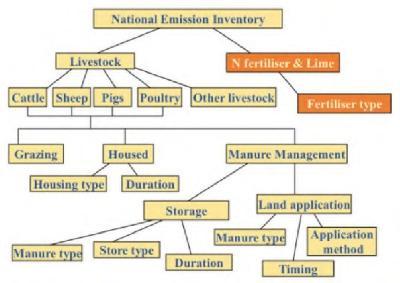12 December 2022
Greenhouse gas mitigation potential of chemical N fertiliser

The National Dairy Conference 2022 took place on Tuesday December 6th, Rochestown Park Hotel, Cork and Thursday December 8th, Mullingar Park Hotel, Co. Westmeath. This paper was presented by Jonathan Herron, Siobhan Kavanagh and Laurence Shalloo, Teagasc.
Summary
- Nitrous oxide makes up 25% of greenhouse gas (GHG) emissions from agriculture. Quantity and type of nitrogen (N) fertiliser are important factors in determining total emissions from this source
- A reduction of 30% in chemical N use and a switch to 100% N in protected urea form can reduce the agricultural sector’s emissions by 5.4% (1.25 Mt CO2-eq). Greater biological fixation of N (clover) will be required to maintain sward productivity
- Changes in N use are accounted for in the national inventory, however the scale of impact for the industry depends on widespread adoption of these practices at farm
Introduction
The agriculture sector as a whole accounted for 37.5% of national GHG emissions in 2021 (EPA, 2022a). Over recent years, farmers have taken steps to drive further carbon efficiency per unit of output, as evidenced by a declining carbon footprint (kg CO2-eq/kg product) of food product from Ireland. However, taking the agricultural sector as a whole, the increase in agricultural output in recent years has contributed to increased overall GHG emissions. In July 2022, the Government agreed ceilings for emissions from each sector of the economy that deliver a pathway towards a 51% reduction by 2030. The ceiling for the agriculture sector will require a cut of 25% (5.76 Mt CO2-eq) in its emissions by 2030 compared to 2018 levels. Implementation of both methane and nitrous oxide emissions reduction measures will be required to meet this target. This will be a significant challenge for agriculture without affecting livestock numbers, as current technologies available to Irish farmers can’t reach that yet. If the targets are to be met with current livestock numbers, it will require development of new technologies, but also more ambition around adoption of existing mitigation options. This paper evaluates the impact of reducing reliance on synthetic N fertiliser and increasing use of protected urea in achieving sectoral GHG emission targets.
How are GHG emissions calculated?
The national inventory is an accounting system, overseen by the Environmental Protection Agency (EPA), which accounts for the total GHG emissions released within the border of Ireland during a given year. The EPA report national GHG emissions across a number of sectors, one of which is agriculture. In contrast to other sectors which are dominated by carbon dioxide, the Irish agricultural sector is dominated by methane and nitrous oxide, contributing over 90% of total agricultural GHG emissions. Figure one provides an overview of the GHG emission sources from the agricultural sector reported in the national inventory.

Figure 1. Overview of agricultural greenhouse gas emission sources in the national inventory
How are emissions from chemical nitrogen fertiliser accounted for in the national inventory?
While methane receives much more media attention and commentary, it is important to note that nitrous oxide made up 25% of total agriculture emissions in 2021 (EPA, 2022a). Nitrous oxide is a potent GHG, with a global warming potential 265 times that of CO2, therefore its mitigation is a key objective for the agricultural industry. The main sources of nitrous oxide emissions from agricultural sector are the application of chemical N fertilisers, the deposition of urine and dung during grazing, and manure management (storage and spreading).
Chemical N releases nitrous oxide into the atmosphere when applied to land. Therefore, the reduction in the quantity of chemical N used will lead to a decline in total GHG emissions from the agricultural sector. The type of chemical N fertiliser used also impacts the quantity of nitrous oxide emissions released following application; protected urea emitting 73.5% less nitrous oxide emissions per kg N applied than calcium ammonium nitrate. In addition to direct nitrous oxide emissions, synthetic N fertilisers also emit carbon dioxide following the application of urea fertiliser, and indirect nitrous oxide from ammonia emissions and nitrate leaching. To calculate fertiliser related emissions the EPA records the quantity and type of chemical nitrogen used in the country in a given year. The national fertiliser usage in 2018 is presented in Table 1 as it is the base year for the Climate Action Plan reduction target of 25%.
The impact of reducing synthetic N fertiliser and increasing use of protected urea
An analysis was conducted to evaluate the impact of reducing chemical N levels nationally and adopting protected urea. All GHG emissions associated with synthetic fertiliser in the national GHG inventory report were consider. The emission sources included were direct N2O emissions following application, CO2 emissions following the application of urea fertiliser, and indirect N2O from ammonia emissions and nitrate leaching. The methodology applied is consistent with the national inventory methodology.
The analysis was completed based on two scenarios. In Scenario 1, chemical N levels applied to pastures were reduced by 30% based on 2018 profile of fertiliser use nationally and then the industry moved to displacing CAN and compounds with 100% protected urea. In Scenario 2, it was assumed that the industry first moved to displacing CAN and compounds with 100% protected urea and then reduced fertiliser levels applied to pastures by 30% nationally. Synthetic N fertiliser use on arable land was reduced by 15% for both scenarios. In all scenarios, it was assumed that most of the chemical N fertiliser reductions was achieved through the incorporation of clover into pastures thus allowing the fixation of atmospheric N.
The analysis shows (Table 2) that whether you move to protected urea first or reduce overall chemical N first, you end up at the same place in terms of the overall emissions reductions
i.e. a reduction in emissions from 2.3 Mt CO2-eq associated with fertiliser use to 1.05 Mt CO2-eq, or 5.4% of the required 25% reduction in emissions from the agricultural sector. However, the order of the movement has a dramatic impact on the advantages associated with reduced chemical N versus a movement to protected urea. The advantage financially as well as from an emissions perspective suggests that the focus at farm level across pasture- based systems should be to move to protected urea based N fertiliser at first and then focus on the N reductions. A Teagasc report published in 2021 (Dillon et al., 2020) that looked at different fertiliser reductions has shown that a reduction in chemical N at farm level would result in a reduction in profitability. Therefore, clover has a key role in replacing chemical N removed at farm level and thus ensuring that there is not a reduction in profitability. Research by McClearn et al. (2020) has shown that the establishment and maintenance of clover will increase profitability by approximately €300 per hectare. The successful industry wide reduction of chemical N will be based on widespread establishment of clover on Irish farms.
Why concentrate on chemical N when methane makes a bigger contribution to greenhouse gas emissions?
The agricultural sector has some technologies in the toolbox that when implemented will provide wins in terms of reducing total emissions. Using protected urea and reducing reliance on chemical N fertiliser through improved nutrient use efficiency and the incorporation of clover into swards are technologies that can be readily implemented. Methane emissions are more difficult to reduce but technologies like improved breeding, reducing age at slaughter and feed additives will all help to reduce methane emissions.
Conclusion
A reduction in the reliance on chemical N by reducing total N used by 30% and a 100% switch to protected urea will reduce total GHG emissions from Irish agriculture by 5.4%. The likelihood of this reduction will be dependent on whether the industry has a strong movement toward protected urea reducing the impact of chemical N reductions. It is recommended that the first step is to move to increase use of protected urea followed by a reduction in chemical N usage.
Read the full National Dairy Conference 2022 publication here
